Somewhere among the reviews in this month’s column, TL‘s 600th review of a local recording appears. Coincidentally, my own 500th review appears as well. I still have each and every one of those recordings, plus another 500 that never got reviewed for lack of space or lack of interest. More amazing still is the fact that we’ve received fully half of those recordings in the past three years. From that standpoint alone, it’s safe to say the local music industry is thriving.
There are tons of bands in the Willamette valley, nearly all of whom are recording their projects somewhere; running off copies in formats ranging from cassette to vinyl to cd. These acts are selling their product in stores which cater to local fans; and they are afforded the opportunity of more venues than ever in which to play.
Very little of this was in place fifteen years ago, when TL first trumpeted the word about the Portland music scene. Change is slow in a small, out of the way burg such as this one. But change has come, and TL has been there every step of the way to capture the incremental shifts that have created the flourishing music scene Portland enjoys today.
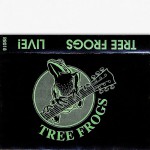 Tree Frogs
Tree Frogs
Tree Frogs Live!
Rainforest Records
Hailed by local pundits as the chief purveyors of Portland’s vaunted and elusive “Eastside Sound,” the friendly Tree Frogs do embody certain aspects of the acoustic renaissance, which is finding the most significant response in the neighborhood pubs of the Eastside. And, doubtless, they are one of the most popular among their kindred folk.
Recorded live, these tunes were culled from four different gigs at the Musicians Local 99 Union hall and offer a fair representation of the music the Tree Frogs render.
“4 Letter Word” kicks off the set with an extended Deadish jam, spearheaded by lead guitarist Fred Stephenson. Rhythm guitarist John Henry Bourke takes the vocal lead here, delicately cooing a melody distantly reminiscent of the Beatles’ “No Reply.” Stephenson’s “Brighter Side” reflects an Early Santana /Doobie Brothers blues feel, augmented by Rob Matthews’ subtle sax and Jeff Haigerty’s harmonica. Keyboardist Bill Leeds contributes “New Beginning” a bouncy reggae tune that recalls the good times feel of Jimmy Buffet. Bourke returns with the infectious “Shine A Light,” which turns on a catchy chord progression and a memorable chorus.
The bands’ funkier side is given some space on the jam “Tuning 060494.” where Matthews is allowed to stretch out on sax and Sean Nowland lays out some badass bottom on bass. Stephenson’s “Picture” features nice three-part vocal harmonies and an honorable sentiment. Leeds’ “Toxic Apple” rides the powerful interplay between drummer Jeff Duffy and Nowland’s bass, covering a lot of musical turf from a heavy intro to a kind of spacy interlude in the middle. Bourke’s “Growing” and “Independence” finish the record on a happy note.
The jams run on a little long here, which is excusable given the live setting. But without the original party to keep the atmosphere buoyant, the casual listener might find the solos to be excessive. With three strong songwriters in the band, the Treefrogs do not lack for versatility.
Mostly there is a certain musical aimlessness, which seems to hold the material back from where it wants to go. If the band were to lay back more frequently, make every note of every solo really mean something integral to the big musical picture and concentrate on ensemble timing–this problem could be corrected.
Other than that, this is a pleasing collection of songs from a talented band, which will charm fans and newcomers alike.
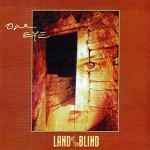 Land Of The Blind
Land Of The Blind
One Eye
Rainforest Records
Land of the Blind have been attracting an evergrowing audience to their live gigs over the past year. Their tightly constructed brand of Worldbeat Technopop invites comparisons to England’s Kate Bush or Peter Gabriel. Vocalist Cyoakha leads the charge, magnificently supported by Jan Deschene and flautist Nancy Cady on powerful vocal harmonies.
Gary Irvine’s keyboard arrangement sets the mood for “Pulling The Walls Down,” where a dark foreboding hovers around Cyoakha’s impassioned vocals. Besides Kate Bush, Tori Amos comes to mind as an influence here. “Seeing Blind” bubbles vibrantly beneath Irvine’s hypnotic synth figure– as the women vocally swoop and soar with unbridled exuberance. Cady’s scintillating flute and guest Skip Parente’s majestic violin solo merge to add an euphoric sensuality to the mix.
A similar air swirls around the smoky atmosphere of “Coming On Strong,” where a droning didgeridoo dances in the smoldering embers of Cyoakha’s fevered vocal. Irvine’s clever synth overlays provide the foundation for the vocal showcase that is “Dream Secrets.”
“Roll Away the Stone” relies on a heavier percussive feel in weaving a dense tapestry of sound over which Cyoakha chants extemporaneously, inviting middle eastern textures to overlap the undercurrent. Parente’s violin continues the middle eastern feel on “Michael.” With LOTB’s cover of Jane Siberry’s “Calling All Angels,” their abundant strengths and few weaknesses are brought into obvious relief. For what this song has that the others don’t is a clear sense of melody. While Cyoakha has a powerful and very beautiful voice, her melodies tend to lack intervals. They hover on a note for a line, move up to another note on the next, becoming much too reliant on technique to disguise their lack of real euphony.
Despite Irvine’s deft arrangements and Cyoakha’s truly inspired vocal performances it is difficult to tell one song from another melodically. Concentration on richer, more developed melody lines to accompany these thoughtful lyrics would yield more effective results.
And Cyoakha would do well to lay off those Kate Bush albums for a while. She has adapted some of the very vocal mannerisms and histrionics that Bush herself has tried to lose over the past five years– mainly because Tori Amos appropriated most of them.
Those few, small complaints aside, One Eye is a dazzling showcase for an outfit that is antithetical to the dingy manifestations of most local bands. This recording offers great promise for an immensely talented ensemble that has yet to truly find its’ own sound. When they do at last surpass their influences, Land of the Blind will be a band with which to be reckoned.
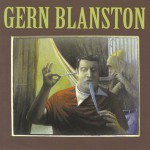 Gern Blanston
Gern Blanston
Gern Blanston
Cavity Search Records
Gern Blanston are a muscular three-piece who show a predilection for detail; delivering hard wrought angst metal with precision and aplomb. Bassist Jillian Blanston and drummer Eric Gern team in support of Jeff Blanston’s stampeding guitar on Cut 1 (I swear I cannot find a song title anywhere on this package). Jeff squeezes air through his tortured larynx as if it were molten glass.
Cut 2 slows down the pace with a gothic instrumental, which is laced with odd tv samples and a chaotic interlude in the middle–yielding the distinct impression that their studio punch may have been spiked a time or two. Jeff Blanston’s guitar work, while not technically difficult, is well-timed and cleverly executed. The last two minutes of this strange piece are very odd indeed. But entirely enjoyable in an ambient, sort of “boppin’ by a creek on a sunny afternoon” kind of way. Wow.
Cut 3 returns to the venomous vigor of the opening cut, slashing and pillaging toward a tightly controlled segue, before storming on to the conclusion. Cut 4 resembles its’ predecessor, but Jeff calms down enough to expulse in a manner that would be considered only mildly to moderately tortured in content. An insistent rhythm and a well-turned middle section add to the overall appeal of this cut– which clearly defines GB’s strengths. Cut 5 continues along similar lines, with the added attraction of Jeff’s vocals here sounding as if they were assembled from portions of King Crimson’s “21st Century Schizoid Man.” Cut 6 adds to the gallery of tormented portraits Jeff seems wont to create.
Bearing a distinct resemblance to Cut 2, Cut 7 stands as another obscure instrumental monument to the glories of found tv dialogue chunks and eclectic guitar stylings. Similarly, the transitional segment leading to Cut 8 is a cliché ridden high horse of junkie/cop chat, that staggers across the stony lonesome Hawaiian 5-0 countryside with grim hilarity. Cut 8, itself, veers closer to Smashing Pumpkins territory and succeeds for the venture. The backwards mantra of the droning conclusion, offers insight into the complex nature of this band.
The ambient portions and Cuts 4 and 8 stand as the highpoints of this collection. Gern Blanston are nothing if not adventurous. That spirit is a wise investment in this 40 minutetour de miserable. For, to get screamed at by Blanston for the duration would be torture to be sure.
They are a very talented band who seem to be doing exactly what they want. If any of the above seems even remotely interesting, then it is certain that you would enjoy this recording.
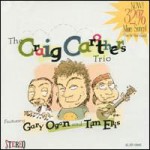 The Craig Carothers Trio
The Craig Carothers Trio
The Craig Carothers Trio
Silent Records
Here’s a 17 song hour of music that’s sure to please a lot of folks, if for no other reason than the quirky selection of material: ranging from show tunes and 40’s Latin send-ups, to a Doors song and a few covers of tv theme songs. These are combined with plenty of Carothers original tunes and a couple of gems submitted by trio keyman Gary Ogan.
Rendered live before a living audience at Whitehorse Studios, this recording benefits from the setting, injecting a welcome sense of merriment to the brooding melancholia often displayed on other Carothers fare.
A consummate songsmith, Craig Carothers manages to turn somber only a few times on this outing, while lending several solid songs, such as the thoughtful “Build A Window,” the pensive “Snowman” and moody “The Fold.” As could be expected, Craig submits a king’s share of clever turns of phrase and philosophical insights, delivering them with the gruff, gravelly voice and detached manner that has garnered him so much acclaim over the years.
“Day At The Beach” is a jaunty exposition regarding the trials of interpersonal relationships. Second guitarist Tim Ellis contributes sprightly high harmonies in the chorus, Ogan lays out pretty open-chord arpeggios and a supple low vocal in the bridge. A subtle reggae feel develops over the bluesy intro of “Import Export;” a lyrically oblique ditty, which ostensibly determines the homogeneity of musical styles: to no particular conclusion.
Perhaps the oddest take is “The Fight Song,” which posits a lighthearted look at spousal abuse and domestic violence: “Kill each other dead if that’s what it comes to/ But do you have to be so loud?” It seems somewhat appropriate that the boys follow this with a tune from South Pacific, “There’s Nothing Like A Dame.” Check the songs out back to back, you’ll figure out why. Tim Ellis handles the difficult libretto with panache, as is true with the bands’ ultra-campy rendition of the 40’s standard “Besame Mucho” (which of course means “kiss me a whole lot” in Spanish). The Russian folk approach to their weird version of “Riders On The Storm,” does no serious damage to the esteemed memory of Mr. Mojo Risin’.
Still, there are even better reasons to obtain this recording. Better reasons than all these. One of them is the convoluted boogie of Gary Ogan’s “Hey Sister,” a song that bears strong evidence of Gary’s days with Leon Russell. The other reason is Ogan’s exquisite “It’s Only Water.” a ballad so utterly gorgeous it could melt Rush Limbaugh’s heart. Anyone who wants a lesson in how to write a song, need only seek out this perfect example of a very difficult craft. Over the years Ogan has produced several of these, guaranteeing him status as Master in this book.
This is fun stuff, and will probably provide a lively lift to some of those stale office Christmas parties. Anyone who enjoys finely hewn songs, given sparse but attractive arrangements– with an added dash of (mostly) well-placed humor, would be drawn to this recording.
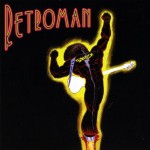 Shock
Shock
Retroman
Locals Only Records
Retroman is right! Roger Sause, who logically contends for the title of “Portland’s Answer To Prince,” weighs in heavily with this sociotopical menage of funky disco tracks.
The disco handclap down beat is incessant, the funky clavinet, drippy synth brass, slicksliding rhythm guitar, slippery rubber basslines. All the 70’s/80’s musical cliché are in place. But it would be entirely inaccurate for one to gather the impression that Sause came home to Portland from LA to merely relive his glory days with Shock. For, he has assimilated those styles to color what could only be called a contemporary funk “concept album.”
While never letting the beat stray from 116 beats per minute, Roger covers an array of social issues: violence in the streets; the corruption of law and order, politics and religion; unemployment and homelessness; and the general disembowlment of the American Dream. Let’s party!
Still, without lapsing into sentimentalism or outright triteness, Sause confronts his topics with a reporters eye and the heart of a bitter saint. Check out the hopeless outlook of “Time Of Our Lives,” or the sociophobic nightmare of “Under The Gun,” the tangled drama of “Ricky’s Point Of View.”
But the cuts that really make it, combine these highly charged elements with sharply barbed hooks that lodge relentlessly in the brain. The whacked out gothicism of “TV Talk Show Utopia” is bathed in warm, fuzzy musical memories of a better time, while the lyrics catalogue the average guests among the 20-odd talk shows playing each day.
Perhaps the big hit (or one of them) is the ascerbic homage to Proposition 16, “Doctor Jack.” “Doctor Jack, he’s got the knack/ He’ll cure the symptoms so they don’t come back.” Lest one get the wrong impression as to where Roger stands on the issue of doctor-assisted suicide, he admits “But you know it’s true, if it was you/ You’d be the first one calling Doctor Jack.” “Eyes On The Prize” may start out sounding like the “Love Boat Theme,” or some Barry White number, but by the time the familiar strains of the punchy chorus arrive, all of that is forgotten.
The final track, “Made In America,” sums up Sause’s feelings about his homeland, while recalling Thomas Dolby. “I’ve heard it from the right wing and I’ve heard it from the left/And I’ve had it with these puppets we continue to elect/ I don’t care what’s sexy and I’m sick of being cool/ And I’m tired of religions with their legalistic rules.” Yeatsian? Well hardly. But Roger makes his points squarely and succinctly.
Throughout the project sidemen, bassist Joe Plass and rhythm guitarist Scott Boyd, contribute splendid support to Sause’s densely embroidered keyboard machinations. This is about as slick as a recording can get.
Obviously, this kind of music won’t appeal to everyone, I can hear the squeak of several factions cringing as these words are written. But just the same, Retroman deserves scrutiny for those who like to have a thought or two provoked while dancing their butts off.
 Monti Amundson and the Blubinos
Monti Amundson and the Blubinos
The Obvious Rock
Locals Only Records
The Blubinos sound continues to evolve. That evolution is neatly captured on this 10 song set.
Witness the thickening of Monti Amundson’s guitar sound on the title track. And, what’s that I hear? Are those background vocals? Harmonies? Yikes! “Lonely” nearly deserts the bands’ Texas R&B sound altogether, for acoustified swamp of the J.J. Cale sort.
Even the blues of “Win For Losin'” seem as if they have been through a tempering process, hardened to blue steel. The approach is restrained and effortless. Drummer Cory Burden and bassist Stan Becraft meld beneath Monti’s inventive guitar. Here, he tosses in a completely unexpected acoustic solo. Whimpering quivers of elastic tears strut across the frets with liquid ease. His vocal is authentic, pure; unadorned of overt technique.
“When It Comes To Love” reverts to the more familiar Blubinos turf, but even here, twin vocals and a poppy chorus will doubtless perplex longtime fans of the old hardcore Blubinos sound. The band has been Europeanized. And the change is all for the better. They have crafted a tough, sassy sound that has evolved away from strict blues roots without losing the essential code.
Any disgruntled fans will be appeased by the inclusion of the Blubinos rendition of Little Richard’s “Miss Ann.” As if to prove that the band have not altogether abandoned their R&B roots, they unleash a straightforward salvo of sweaty roadhouse whiskeyrock. “Drive All Night” bears the mark of Monti’s highly stylized turnaround fills, and a smokin’ solo. This cut leads into fiery live versions of the chestnuts “Route 66” and “My Baby Left Me.”
The pick of this nifty litter is the final track “King’s New Clothes.” Alternating a strident triple time rhythm guitar figure against a buoyant arpeggiated section, the verses snap and crackle with crispy facility. A slashing series of solos defoliate the musical terrain, before returning to the high voltage verse. You can hear the ghosts of Jimi and Stevie Ray hovering around in the ozone. You can hear a band in full gear with somewhere to go.
This is a breakthrough recording for Monti Amundson and the Blubinos. While maintaining their deeply extended roots, they have grafted to their sound branches from other musical trees. It’s hybrid stuff all the way. But far more satisfying than anything they have ever released.
———————————————————————————–
A Look Back On 1994
Well music lovers, 1994 was a big year for Portland bands– the first year ever in which two local acts have been signed to major label contracts. Everclear’s megadeal with Capitol was quickly followed by Pilot’s inking with Electra. Rumors abound around town as to who will be the next to sign on the dotted line.
Several other bands are on major indie labels, tour extensively and only play in Portland every few months ala Pond and Sweaty Nipples. And there are a few other bands, such as Cherry Poppin’ Daddies, Renegade Saints and Dead Moon, who command such huge local followings that they need only play in town infrequently to keep their coffers full.
Other bands are simply folding. Crazy 8’s led the way for a lot of local horn bands, but finally fell prey to the public’s insatiable hunger for the new and outrageous.
In a short period of time the local musical landscape has shifted. Billing on important nights at good clubs is suddenly available. With a shift at the top of the chain, a resultant flurry of movement down the line is not unexpected.
So, as we embark into 1995, the logical successors to the top of the heap are manifold, diverse and talented. My crystal ball tells me to keep your eye on 30.06, Heatmiser, Nero’s Rome and Gern Blanston, But watch for Skiploader, Rubberneck, Five Fingers of Funk, Gift, Picklehead, Molly Cliff, Silicone Jones, Skinhorse, Haymaker, Gravelpit, the Violets, Swoon 23 and Dandy Warhols. Also moving up slots will be Floater, Tales Untold, The Willies, Sissyface, Lesserface, On A Llama, Land of the Blind, Alphabitch and The Canaries.
The folk scene is headed by the Treefrogs, Colobo, Higher Ground, Kelly Joe Phelps and the Crackpots. But look for Kaitlyn Ni Donovan and Cheralee Dillon, Wick and McKinley.
And who are the new bands to loom just over the horizon? What new clubs and attitudes will form the fabric of 1995? What rumors and stories? A well known local source informs me that Courtney Love is pregnant by Trent Reznor. Will that rumor come to fruition in 1995? And what about all the bad feelings and horror stories Everclear left in their wake before blowing out of town on a bankroll? Why doesn’t anyone have anything nice to say about Everclear? And whatever happened to Tim Morreau?
Ah, another year to contemplate these and the other vicissitudes of contemporary existence. What ho! Let’s get on with it!
———————————————————————————–
With the death of the X-Ray Cafe, last month, came an end to another era in the Portland music scene. Many among the scene decry its’ condition. But, with a modicum of perspective painted into the picture, it becomes clear that a vibrant industry thrives just beneath the torpid surface. And it is clear too that despite the transitory nature of the music business that the elements are in place for this industry to flourish for many years to come.
Ten years ago there were only a handful of clubs where a musician playing original material could perform. In many cases, just as today, those clubs would die nearly as fast as they would spring up. It’s the nature of the beast. Today, there are nearly fifty venues where one can catch live, original music on any night of the week.
Like the city itself, the river divides the two essential music scenes which generate the locomotion. Downtown, there are a cluster of clubs within one hundred square blocks: the Roseland for the big shows; Satyricon as a bastion to a way of life; Key Largo, which still offers one of the most diverse musical calendars in town, continues a long-standing tradition. All musical tastes can be accommodated downtown: Reggae and World Beat at the Red Sea, Salsa at Sandoval’s. Eli’s has surfaced yet again to provide an outlet for Metal bands. Catch the Blues at the Candlelight Room and Kelly’s, and folk at Vinnie’s.
Vinnie’s serves as a conduit to what is happening on the Eastside by presenting a folk/unplugged menu that seems to predominate on the other side of the river, where clubs must contend with neighborhoods and irate neighbors who complain of the late night noise and activity.
And a newcomer to the downtown scene, the 1201 Club, at 1201 S.W. 12th, offers an ambiance heretofore unfound in the annals of local music clubs. It’s a smoky lounge with intense red decor and plump leather booths, that is clearly from some other era–but well preserved all the same; presenting Folk and and light alternative. Recent performances by the Dandy Warhols, and solos by Kaitlyn ni Donovan and Lew Jones were played to full houses of appreciative hipsters. Word seems to have already gotten out about the 1201 Club.
Fully, there are twenty music venues on the inner Eastside presenting such a variety of acts it’s hard to pinpoint a sound . But truly there is something happening at a grassroots level that has met with a lot of success.
La Luna aims to satisfy all your corporeal requirements under a single roof–can penthouse apartments be far behind? Still, La Luna is the city’s musical hub–presenting top national and local acts in an ever changing array.
The Dandelion on Grand, offers folk/blues, as does Produce Row, where the fare can sometimes rock a little harder. The Aladdin Theater is booking noteworthy national acts with growing frequency.
A recent show at the East Avenue Tavern, “Girls,Girls,Girls,” staged by Lisa Lepine, drew an SRO response to the performances of six local female solo singers. Cheralee Dillon, Maria Webster and Kaitlyn ni Donovan were standouts. Look for “Boys,Boys,Boys” on September 22. As for the naming of the event, the PC among you will want to contact Lisa.
But Hawthorne Boulevard acts as music row. There are five venues along a mile of Hawthorne offering the most variegated of formats. Parchman Farm is a longtime Jazz bar that has moved toward Blues and R&B. Bojangles serves up a Blues format, occasionally booking national acts, Iron Butterfly being the most notable quirk. Right next door is Cafe Lena, an eclectic space where poets and solo musical acts vie for mic time. Mark’s Hawthorne Pub delivers a diverse mix of Folk, R&B and Rock. Mt. Tabor Pub & Cinema could be considered little La Luna with a better theater and less attitude.
Nearby Belmont’s Inn books many of the same bands as Mt.Tabor– most of the better alternative acts in town and a few touring bands. The Laurelthirst caters to the unplugged and Folk/Rock crowd. Many bands have made a mini-circuit out of playing these three clubs.
Several of these bands have extended their turf to the burgeoning scene in the central Northside, where, for a long time, only the White Eagle has stood as a beacon of whiskey flavored rock. Madrona Hill Winery has sprung up, just up the hill, scheduling many of the same acts usually found further south. The Rose and Thistle on Broadway has promoted similar bookings.
Even the deep Eastside is seeing a resurgence–with the Moosehead, Yen Ha, Thatcher’s and Powell Street Depot offering live original music on a regular basis.
This is not an inclusive list. There are venues in the upper North, in the Northwest, and as far west as Beaverton. Any band that complains of not having a place to play either isn’t trying very hard to fit in or doesn’t want to. There must be five hundred musical acts in Portland who do want to fit in somewhere and most of them do. The competition remains fierce for opportune slots on the good bill and the choice night. It remains true that cream rises to the top.
The death of X-Ray Cafe will create a hole that won’t be easily filled. There will always be a need in Portland for an underage club. Ben Ellis and Tres Shannon deserve nothing but praise for their farsighted vision in attempting to make such a daring enterprise fly. And, for many bands, it means one less place for them to play. But one thing the perspective of time affords to any initiate is the sense that holes were meant to be filled and that someone usually comes along to do the job.
It’s the bands who need to widen their scope. Many bands do not see opportunities right under their noses. Thus, many Eastsiders refuse to play downtown, Downtowners feel it uncool to play the Eastside. Many bands are unable to express themselves at any volume under 110db. Those are some of the self-imposed limitations bands place upon themselves in an attempt to fail and fail again: in order to support a perverse notion of being rebel outsiders.
By opening their minds to the possibilities that exist for them; by widening their perspective to include the new and unproven, bands can enhance immensely the chances for their own success.
